Analysis of Parmalat's Corporate Governance Failures: A Case Study
VerifiedAdded on 2020/03/04
|9
|1456
|50
Report
AI Summary
This report provides an in-depth analysis of the corporate governance failures of the Italian dairy company, Parmalat. It examines the organizational structure, focusing on issues such as the complex ownership structure, the lack of protection for minority shareholders, and the misuse of corporate resources. The report identifies specific failures, including the absence of independent directors, and explores how these failures contributed to the company's downfall. The report also suggests mechanisms that Parmalat could have implemented to mitigate risks, such as a well-defined hierarchical organizational structure, adherence to Italian corporate governance policies, and effective stakeholder management. Finally, it discusses the roles of key participants in corporate governance, including non-executive directors, internal audit committees, and the board of directors, emphasizing the importance of ethical performance and accountability as well as compliance with SOX and SEC regulations. The analysis highlights the importance of robust corporate governance for organizational sustainability and success.
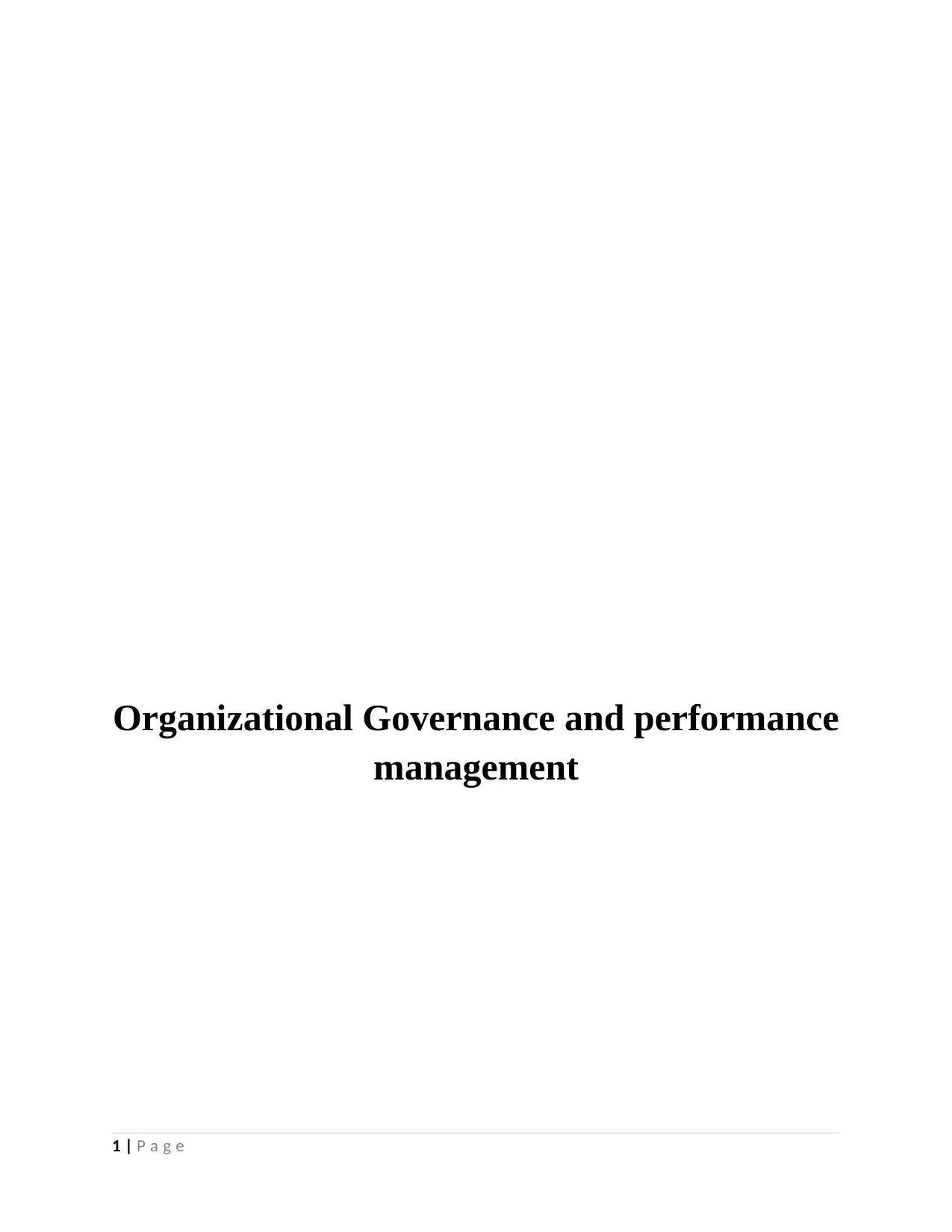
Organizational Governance and performance
management
1 | P a g e
management
1 | P a g e
Paraphrase This Document
Need a fresh take? Get an instant paraphrase of this document with our AI Paraphraser
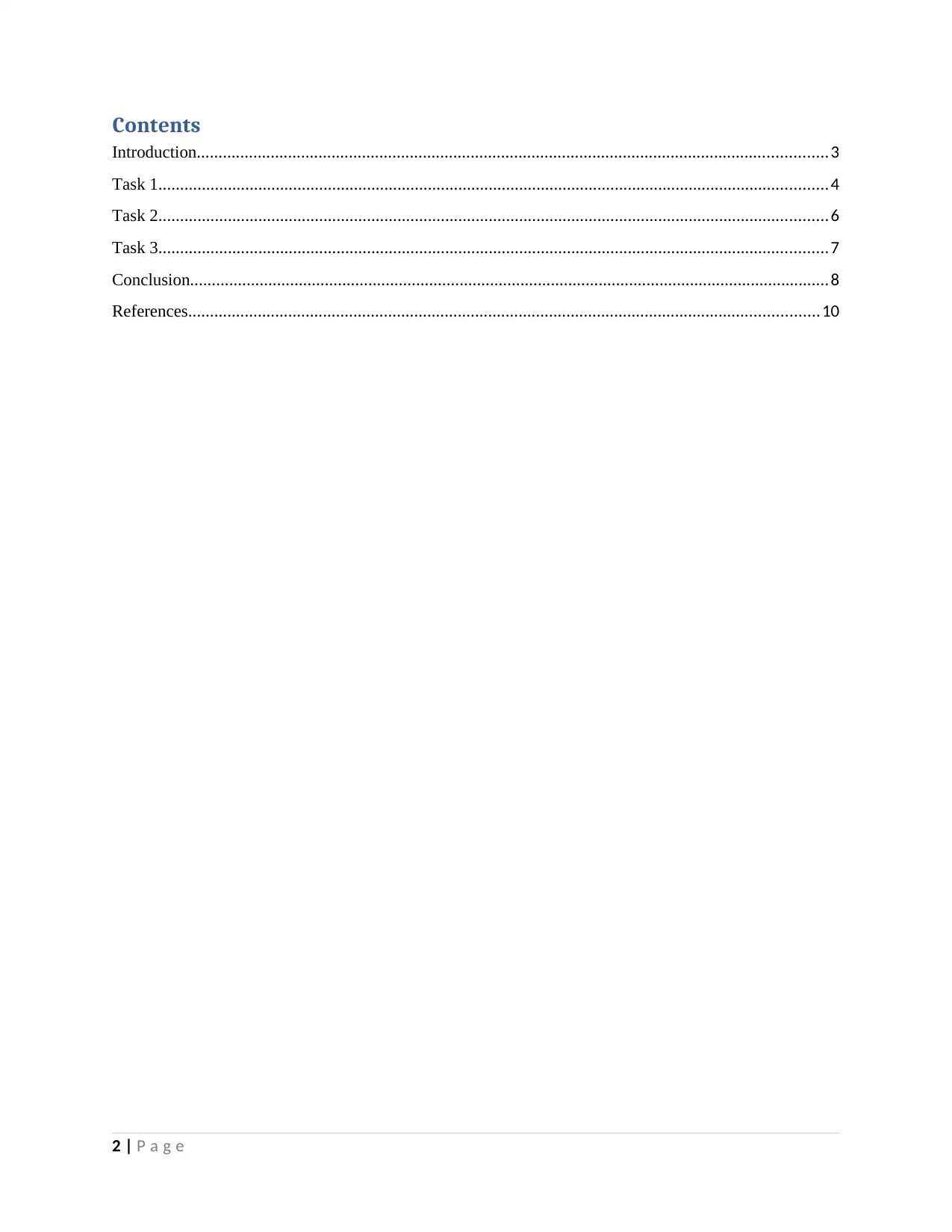
Contents
Introduction.................................................................................................................................................3
Task 1..........................................................................................................................................................4
Task 2..........................................................................................................................................................6
Task 3..........................................................................................................................................................7
Conclusion...................................................................................................................................................8
References.................................................................................................................................................10
2 | P a g e
Introduction.................................................................................................................................................3
Task 1..........................................................................................................................................................4
Task 2..........................................................................................................................................................6
Task 3..........................................................................................................................................................7
Conclusion...................................................................................................................................................8
References.................................................................................................................................................10
2 | P a g e
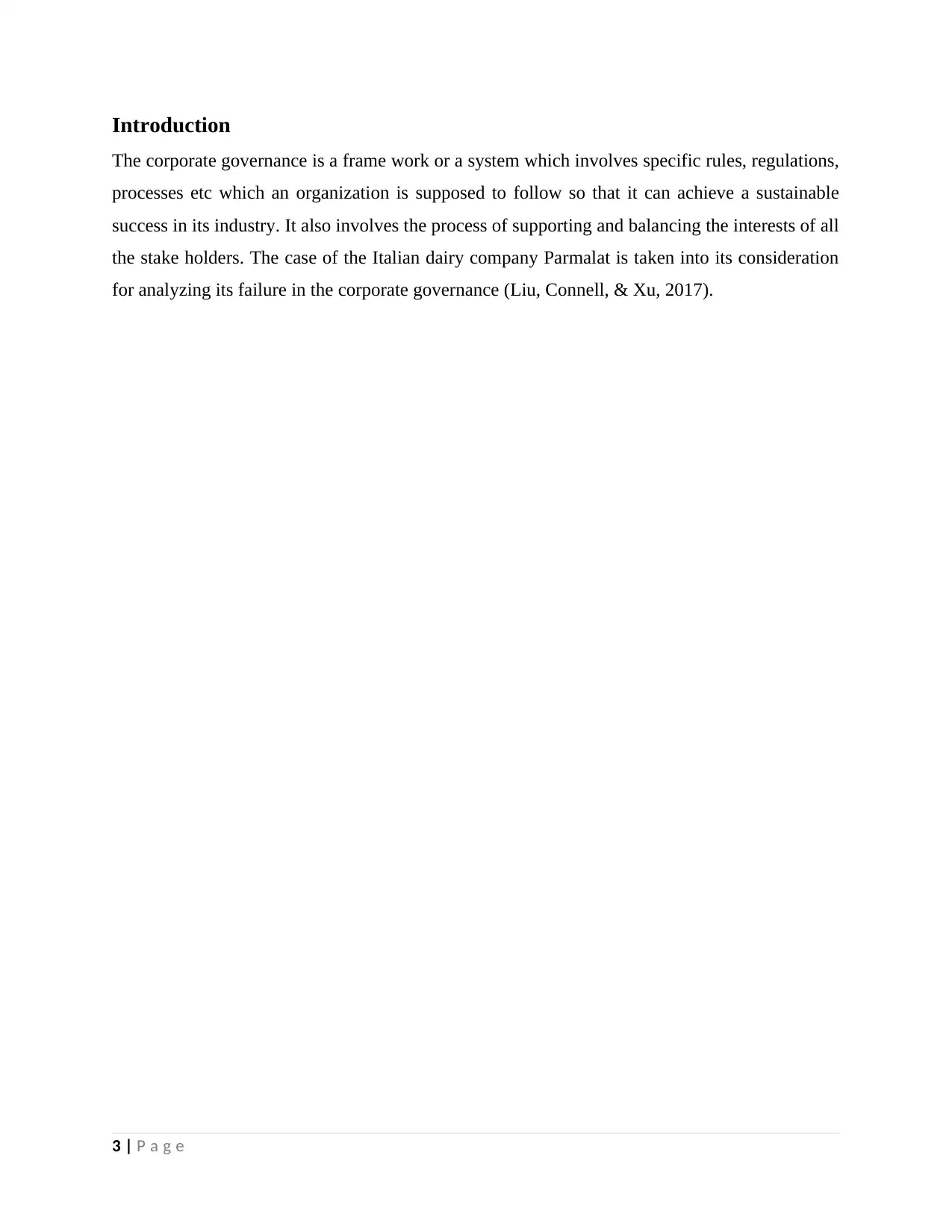
Introduction
The corporate governance is a frame work or a system which involves specific rules, regulations,
processes etc which an organization is supposed to follow so that it can achieve a sustainable
success in its industry. It also involves the process of supporting and balancing the interests of all
the stake holders. The case of the Italian dairy company Parmalat is taken into its consideration
for analyzing its failure in the corporate governance (Liu, Connell, & Xu, 2017).
3 | P a g e
The corporate governance is a frame work or a system which involves specific rules, regulations,
processes etc which an organization is supposed to follow so that it can achieve a sustainable
success in its industry. It also involves the process of supporting and balancing the interests of all
the stake holders. The case of the Italian dairy company Parmalat is taken into its consideration
for analyzing its failure in the corporate governance (Liu, Connell, & Xu, 2017).
3 | P a g e
⊘ This is a preview!⊘
Do you want full access?
Subscribe today to unlock all pages.

Trusted by 1+ million students worldwide
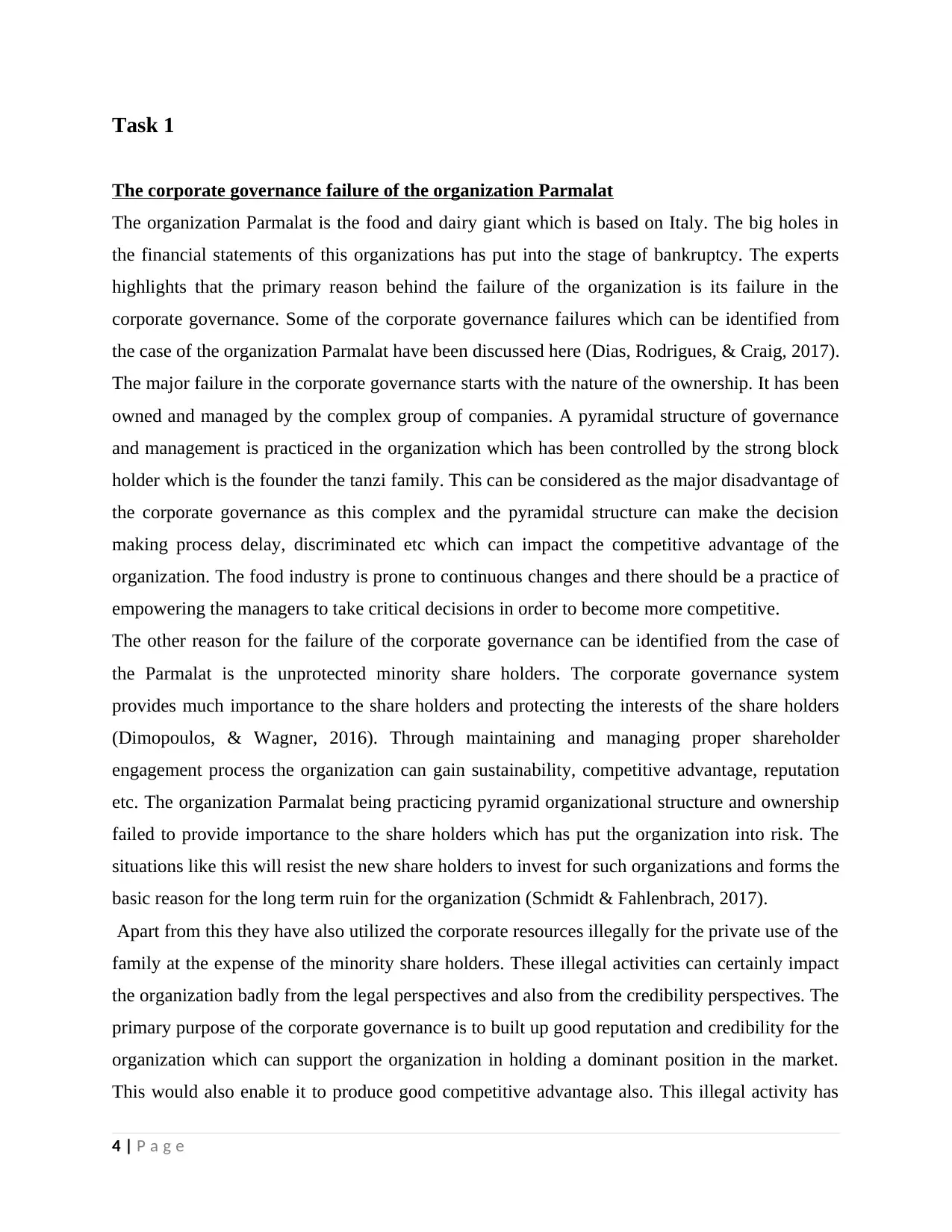
Task 1
The corporate governance failure of the organization Parmalat
The organization Parmalat is the food and dairy giant which is based on Italy. The big holes in
the financial statements of this organizations has put into the stage of bankruptcy. The experts
highlights that the primary reason behind the failure of the organization is its failure in the
corporate governance. Some of the corporate governance failures which can be identified from
the case of the organization Parmalat have been discussed here (Dias, Rodrigues, & Craig, 2017).
The major failure in the corporate governance starts with the nature of the ownership. It has been
owned and managed by the complex group of companies. A pyramidal structure of governance
and management is practiced in the organization which has been controlled by the strong block
holder which is the founder the tanzi family. This can be considered as the major disadvantage of
the corporate governance as this complex and the pyramidal structure can make the decision
making process delay, discriminated etc which can impact the competitive advantage of the
organization. The food industry is prone to continuous changes and there should be a practice of
empowering the managers to take critical decisions in order to become more competitive.
The other reason for the failure of the corporate governance can be identified from the case of
the Parmalat is the unprotected minority share holders. The corporate governance system
provides much importance to the share holders and protecting the interests of the share holders
(Dimopoulos, & Wagner, 2016). Through maintaining and managing proper shareholder
engagement process the organization can gain sustainability, competitive advantage, reputation
etc. The organization Parmalat being practicing pyramid organizational structure and ownership
failed to provide importance to the share holders which has put the organization into risk. The
situations like this will resist the new share holders to invest for such organizations and forms the
basic reason for the long term ruin for the organization (Schmidt & Fahlenbrach, 2017).
Apart from this they have also utilized the corporate resources illegally for the private use of the
family at the expense of the minority share holders. These illegal activities can certainly impact
the organization badly from the legal perspectives and also from the credibility perspectives. The
primary purpose of the corporate governance is to built up good reputation and credibility for the
organization which can support the organization in holding a dominant position in the market.
This would also enable it to produce good competitive advantage also. This illegal activity has
4 | P a g e
The corporate governance failure of the organization Parmalat
The organization Parmalat is the food and dairy giant which is based on Italy. The big holes in
the financial statements of this organizations has put into the stage of bankruptcy. The experts
highlights that the primary reason behind the failure of the organization is its failure in the
corporate governance. Some of the corporate governance failures which can be identified from
the case of the organization Parmalat have been discussed here (Dias, Rodrigues, & Craig, 2017).
The major failure in the corporate governance starts with the nature of the ownership. It has been
owned and managed by the complex group of companies. A pyramidal structure of governance
and management is practiced in the organization which has been controlled by the strong block
holder which is the founder the tanzi family. This can be considered as the major disadvantage of
the corporate governance as this complex and the pyramidal structure can make the decision
making process delay, discriminated etc which can impact the competitive advantage of the
organization. The food industry is prone to continuous changes and there should be a practice of
empowering the managers to take critical decisions in order to become more competitive.
The other reason for the failure of the corporate governance can be identified from the case of
the Parmalat is the unprotected minority share holders. The corporate governance system
provides much importance to the share holders and protecting the interests of the share holders
(Dimopoulos, & Wagner, 2016). Through maintaining and managing proper shareholder
engagement process the organization can gain sustainability, competitive advantage, reputation
etc. The organization Parmalat being practicing pyramid organizational structure and ownership
failed to provide importance to the share holders which has put the organization into risk. The
situations like this will resist the new share holders to invest for such organizations and forms the
basic reason for the long term ruin for the organization (Schmidt & Fahlenbrach, 2017).
Apart from this they have also utilized the corporate resources illegally for the private use of the
family at the expense of the minority share holders. These illegal activities can certainly impact
the organization badly from the legal perspectives and also from the credibility perspectives. The
primary purpose of the corporate governance is to built up good reputation and credibility for the
organization which can support the organization in holding a dominant position in the market.
This would also enable it to produce good competitive advantage also. This illegal activity has
4 | P a g e
Paraphrase This Document
Need a fresh take? Get an instant paraphrase of this document with our AI Paraphraser
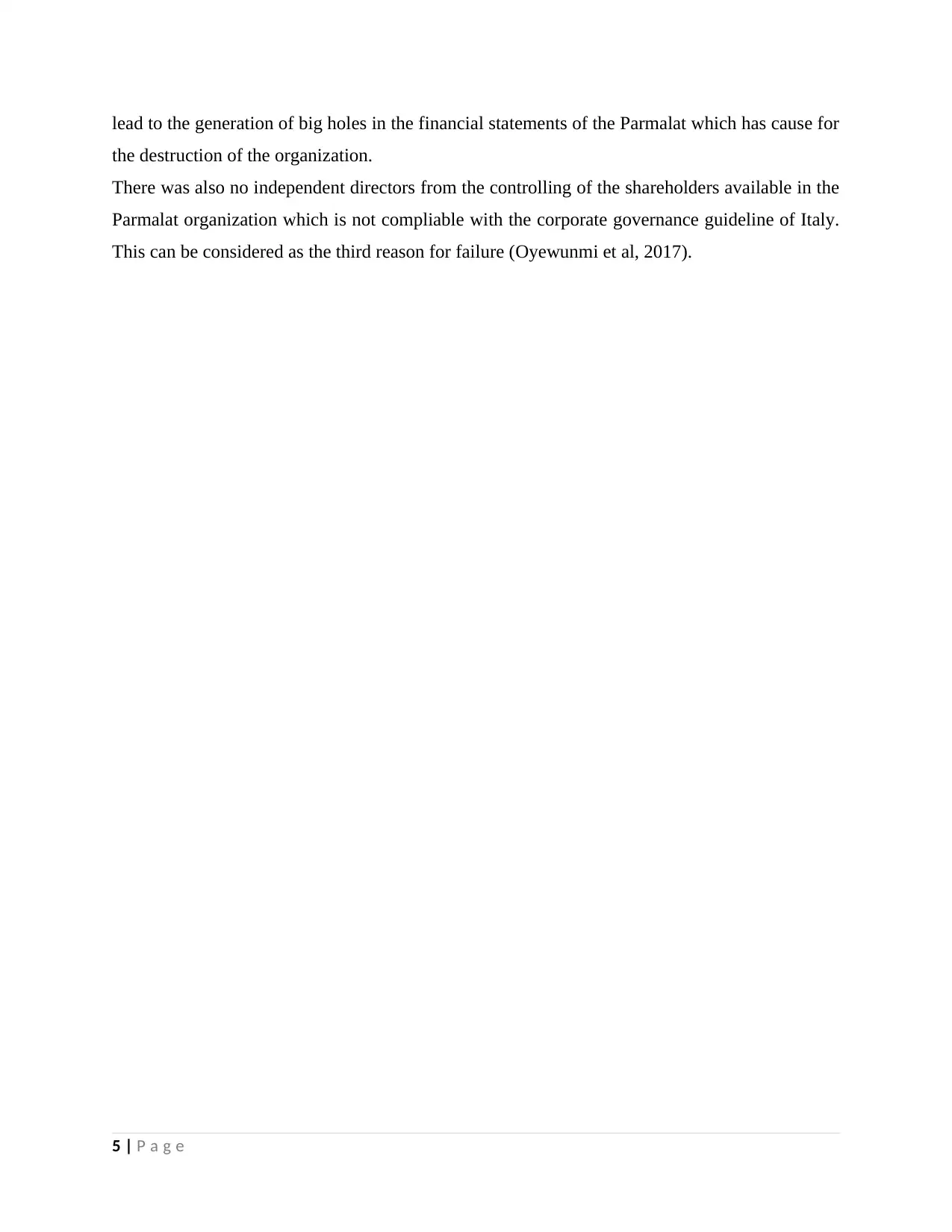
lead to the generation of big holes in the financial statements of the Parmalat which has cause for
the destruction of the organization.
There was also no independent directors from the controlling of the shareholders available in the
Parmalat organization which is not compliable with the corporate governance guideline of Italy.
This can be considered as the third reason for failure (Oyewunmi et al, 2017).
5 | P a g e
the destruction of the organization.
There was also no independent directors from the controlling of the shareholders available in the
Parmalat organization which is not compliable with the corporate governance guideline of Italy.
This can be considered as the third reason for failure (Oyewunmi et al, 2017).
5 | P a g e
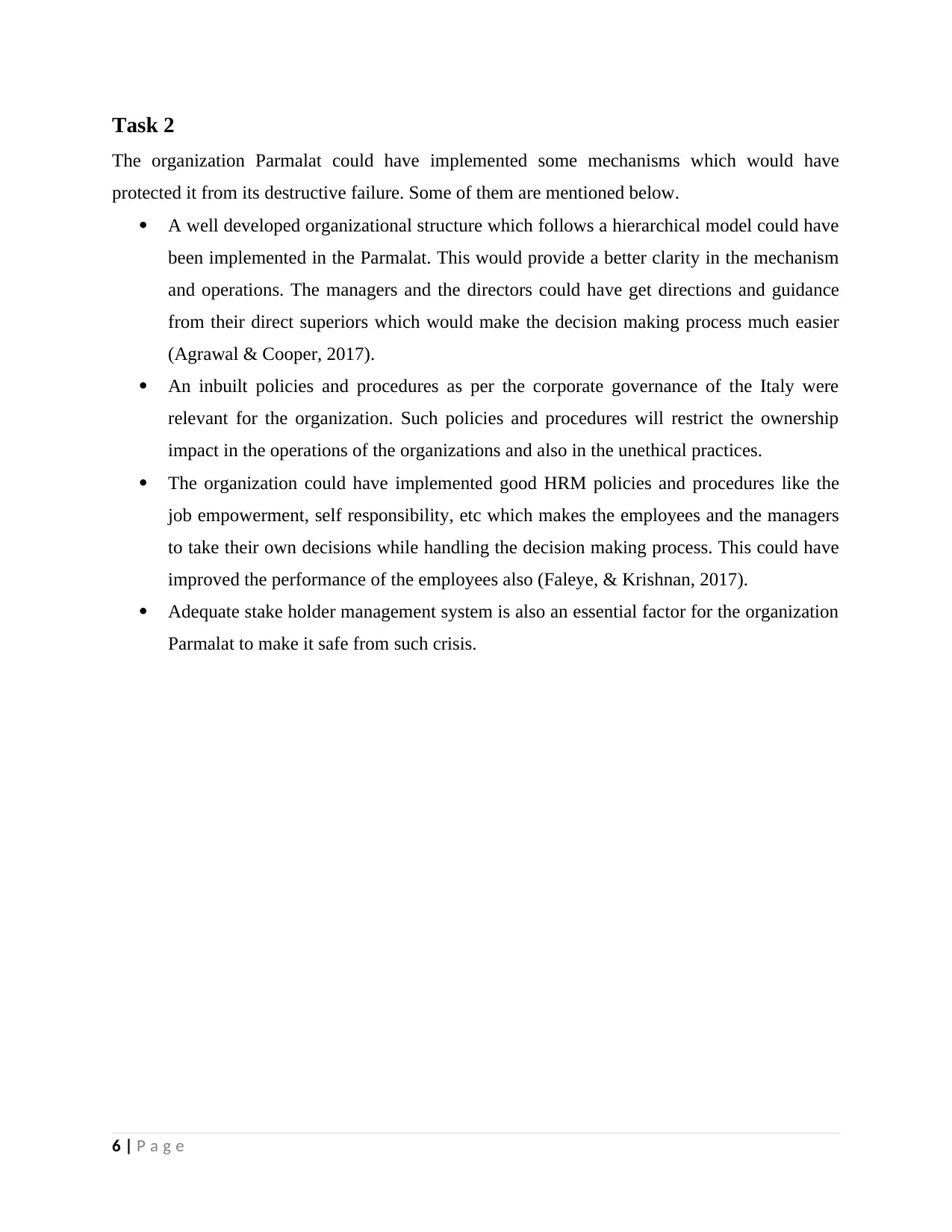
Task 2
The organization Parmalat could have implemented some mechanisms which would have
protected it from its destructive failure. Some of them are mentioned below.
A well developed organizational structure which follows a hierarchical model could have
been implemented in the Parmalat. This would provide a better clarity in the mechanism
and operations. The managers and the directors could have get directions and guidance
from their direct superiors which would make the decision making process much easier
(Agrawal & Cooper, 2017).
An inbuilt policies and procedures as per the corporate governance of the Italy were
relevant for the organization. Such policies and procedures will restrict the ownership
impact in the operations of the organizations and also in the unethical practices.
The organization could have implemented good HRM policies and procedures like the
job empowerment, self responsibility, etc which makes the employees and the managers
to take their own decisions while handling the decision making process. This could have
improved the performance of the employees also (Faleye, & Krishnan, 2017).
Adequate stake holder management system is also an essential factor for the organization
Parmalat to make it safe from such crisis.
6 | P a g e
The organization Parmalat could have implemented some mechanisms which would have
protected it from its destructive failure. Some of them are mentioned below.
A well developed organizational structure which follows a hierarchical model could have
been implemented in the Parmalat. This would provide a better clarity in the mechanism
and operations. The managers and the directors could have get directions and guidance
from their direct superiors which would make the decision making process much easier
(Agrawal & Cooper, 2017).
An inbuilt policies and procedures as per the corporate governance of the Italy were
relevant for the organization. Such policies and procedures will restrict the ownership
impact in the operations of the organizations and also in the unethical practices.
The organization could have implemented good HRM policies and procedures like the
job empowerment, self responsibility, etc which makes the employees and the managers
to take their own decisions while handling the decision making process. This could have
improved the performance of the employees also (Faleye, & Krishnan, 2017).
Adequate stake holder management system is also an essential factor for the organization
Parmalat to make it safe from such crisis.
6 | P a g e
⊘ This is a preview!⊘
Do you want full access?
Subscribe today to unlock all pages.

Trusted by 1+ million students worldwide
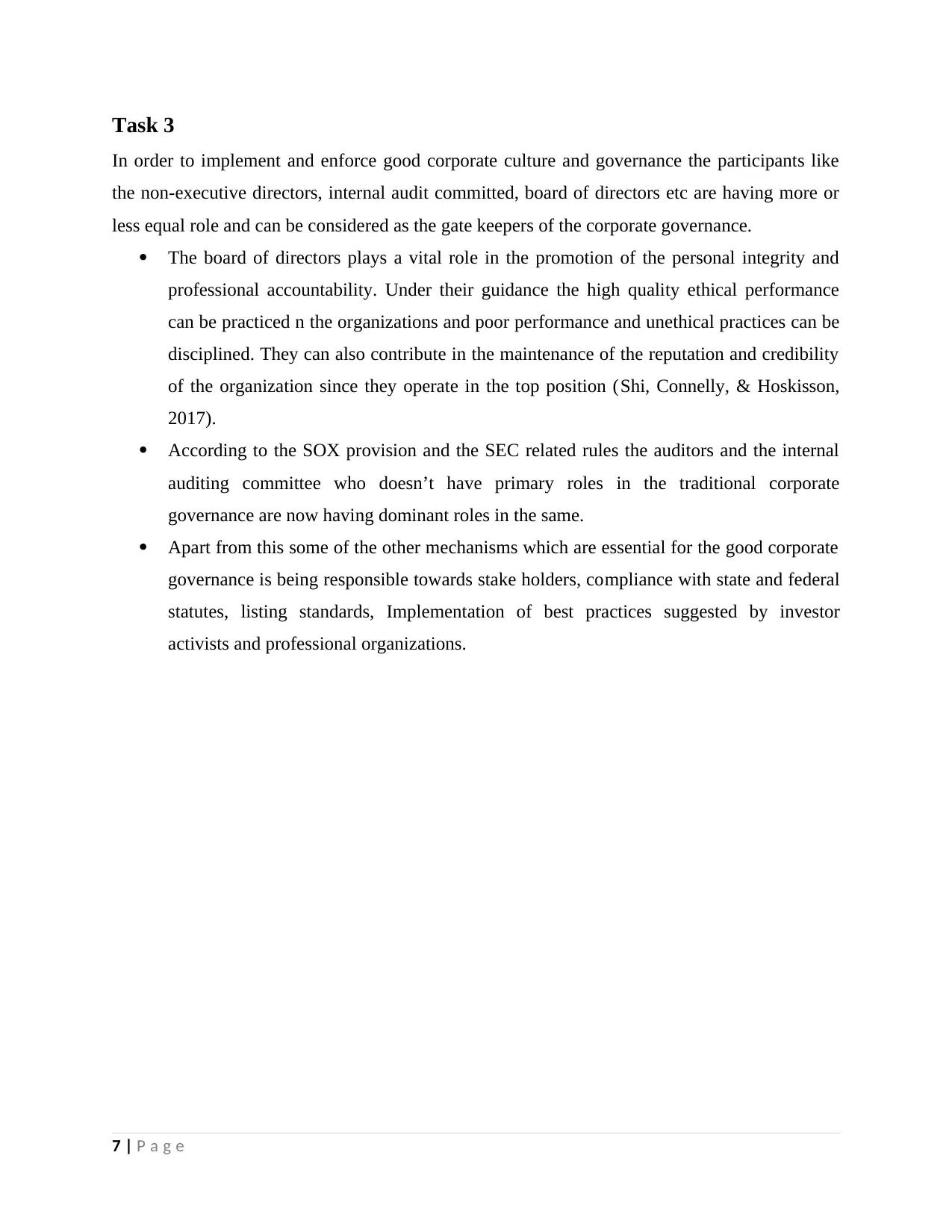
Task 3
In order to implement and enforce good corporate culture and governance the participants like
the non-executive directors, internal audit committed, board of directors etc are having more or
less equal role and can be considered as the gate keepers of the corporate governance.
The board of directors plays a vital role in the promotion of the personal integrity and
professional accountability. Under their guidance the high quality ethical performance
can be practiced n the organizations and poor performance and unethical practices can be
disciplined. They can also contribute in the maintenance of the reputation and credibility
of the organization since they operate in the top position (Shi, Connelly, & Hoskisson,
2017).
According to the SOX provision and the SEC related rules the auditors and the internal
auditing committee who doesn’t have primary roles in the traditional corporate
governance are now having dominant roles in the same.
Apart from this some of the other mechanisms which are essential for the good corporate
governance is being responsible towards stake holders, compliance with state and federal
statutes, listing standards, Implementation of best practices suggested by investor
activists and professional organizations.
7 | P a g e
In order to implement and enforce good corporate culture and governance the participants like
the non-executive directors, internal audit committed, board of directors etc are having more or
less equal role and can be considered as the gate keepers of the corporate governance.
The board of directors plays a vital role in the promotion of the personal integrity and
professional accountability. Under their guidance the high quality ethical performance
can be practiced n the organizations and poor performance and unethical practices can be
disciplined. They can also contribute in the maintenance of the reputation and credibility
of the organization since they operate in the top position (Shi, Connelly, & Hoskisson,
2017).
According to the SOX provision and the SEC related rules the auditors and the internal
auditing committee who doesn’t have primary roles in the traditional corporate
governance are now having dominant roles in the same.
Apart from this some of the other mechanisms which are essential for the good corporate
governance is being responsible towards stake holders, compliance with state and federal
statutes, listing standards, Implementation of best practices suggested by investor
activists and professional organizations.
7 | P a g e
Paraphrase This Document
Need a fresh take? Get an instant paraphrase of this document with our AI Paraphraser
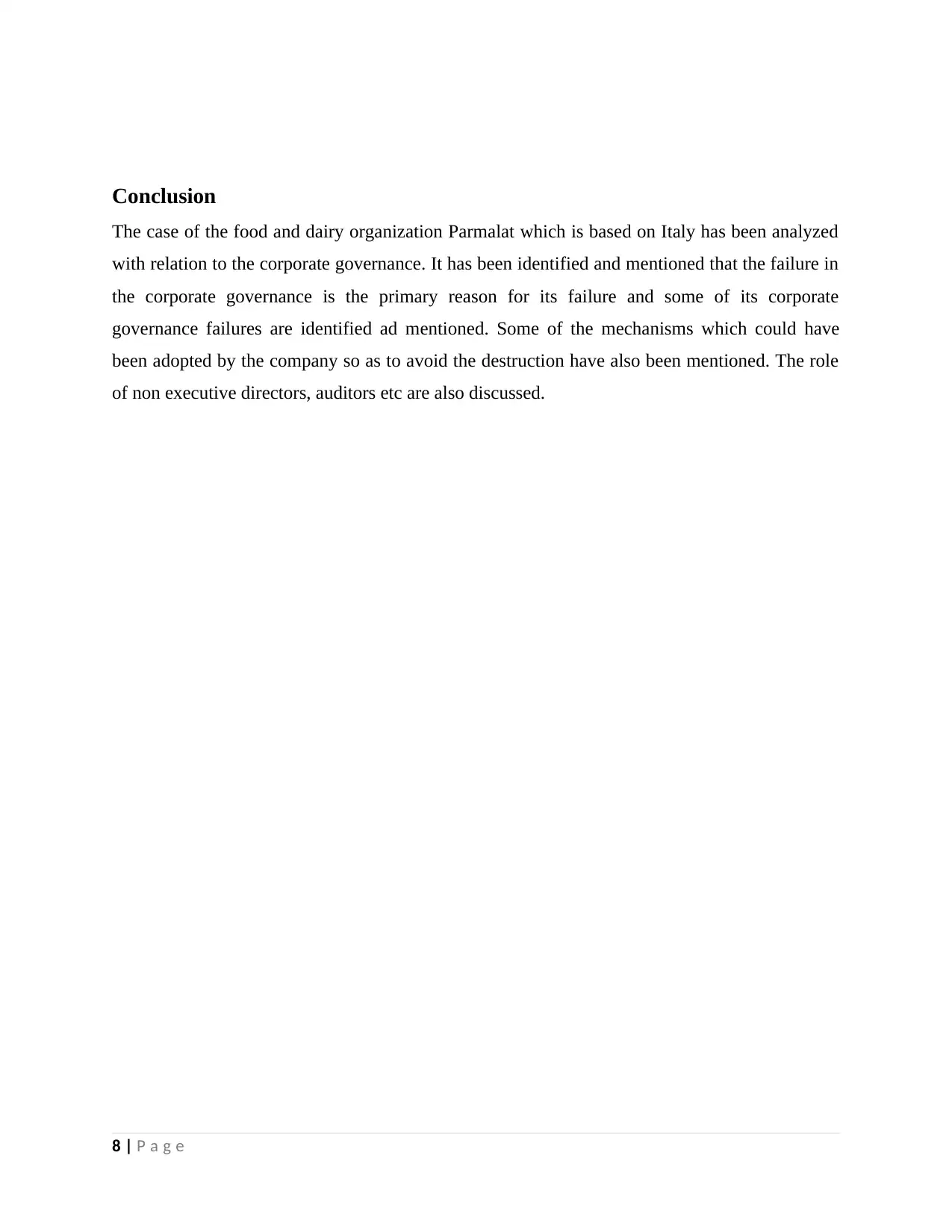
Conclusion
The case of the food and dairy organization Parmalat which is based on Italy has been analyzed
with relation to the corporate governance. It has been identified and mentioned that the failure in
the corporate governance is the primary reason for its failure and some of its corporate
governance failures are identified ad mentioned. Some of the mechanisms which could have
been adopted by the company so as to avoid the destruction have also been mentioned. The role
of non executive directors, auditors etc are also discussed.
8 | P a g e
The case of the food and dairy organization Parmalat which is based on Italy has been analyzed
with relation to the corporate governance. It has been identified and mentioned that the failure in
the corporate governance is the primary reason for its failure and some of its corporate
governance failures are identified ad mentioned. Some of the mechanisms which could have
been adopted by the company so as to avoid the destruction have also been mentioned. The role
of non executive directors, auditors etc are also discussed.
8 | P a g e
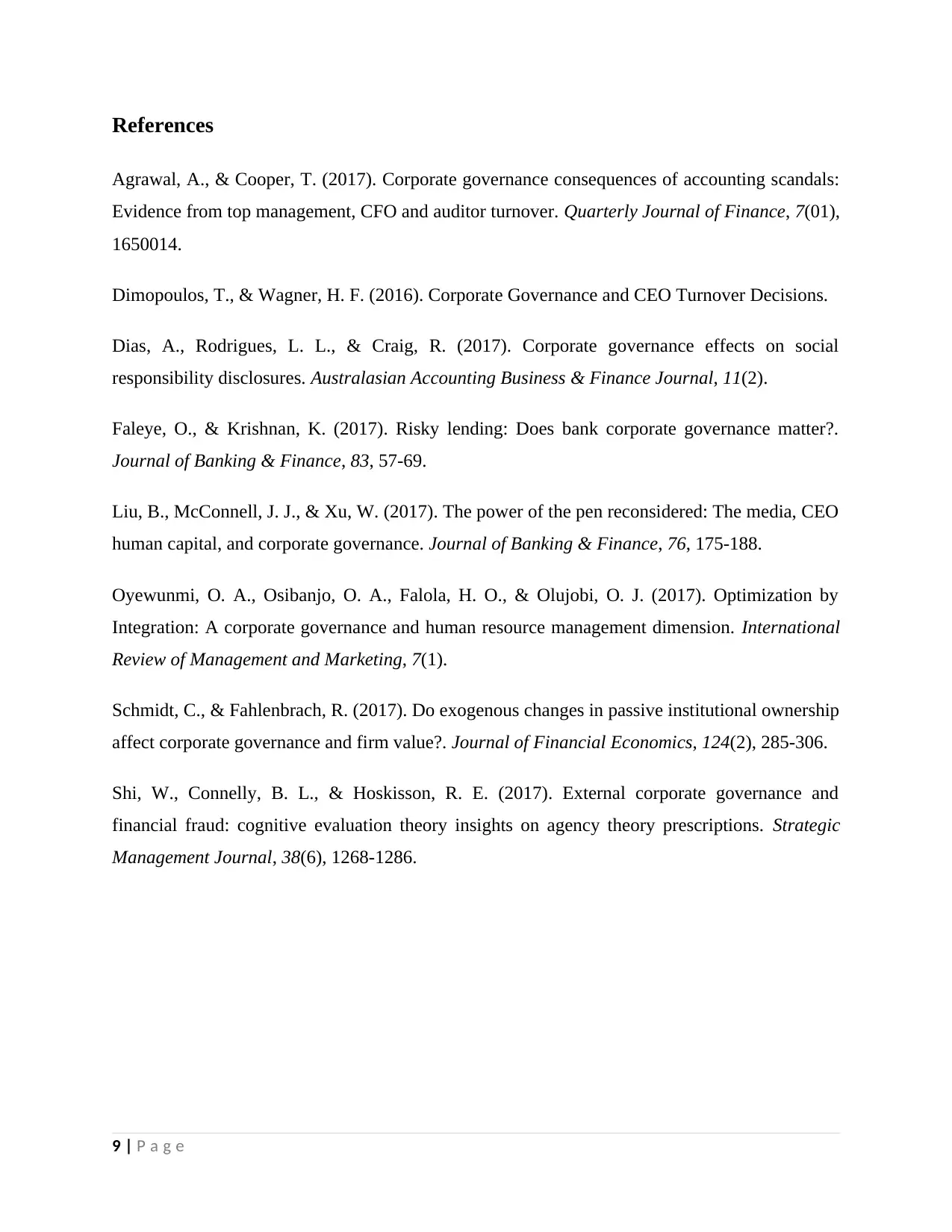
References
Agrawal, A., & Cooper, T. (2017). Corporate governance consequences of accounting scandals:
Evidence from top management, CFO and auditor turnover. Quarterly Journal of Finance, 7(01),
1650014.
Dimopoulos, T., & Wagner, H. F. (2016). Corporate Governance and CEO Turnover Decisions.
Dias, A., Rodrigues, L. L., & Craig, R. (2017). Corporate governance effects on social
responsibility disclosures. Australasian Accounting Business & Finance Journal, 11(2).
Faleye, O., & Krishnan, K. (2017). Risky lending: Does bank corporate governance matter?.
Journal of Banking & Finance, 83, 57-69.
Liu, B., McConnell, J. J., & Xu, W. (2017). The power of the pen reconsidered: The media, CEO
human capital, and corporate governance. Journal of Banking & Finance, 76, 175-188.
Oyewunmi, O. A., Osibanjo, O. A., Falola, H. O., & Olujobi, O. J. (2017). Optimization by
Integration: A corporate governance and human resource management dimension. International
Review of Management and Marketing, 7(1).
Schmidt, C., & Fahlenbrach, R. (2017). Do exogenous changes in passive institutional ownership
affect corporate governance and firm value?. Journal of Financial Economics, 124(2), 285-306.
Shi, W., Connelly, B. L., & Hoskisson, R. E. (2017). External corporate governance and
financial fraud: cognitive evaluation theory insights on agency theory prescriptions. Strategic
Management Journal, 38(6), 1268-1286.
9 | P a g e
Agrawal, A., & Cooper, T. (2017). Corporate governance consequences of accounting scandals:
Evidence from top management, CFO and auditor turnover. Quarterly Journal of Finance, 7(01),
1650014.
Dimopoulos, T., & Wagner, H. F. (2016). Corporate Governance and CEO Turnover Decisions.
Dias, A., Rodrigues, L. L., & Craig, R. (2017). Corporate governance effects on social
responsibility disclosures. Australasian Accounting Business & Finance Journal, 11(2).
Faleye, O., & Krishnan, K. (2017). Risky lending: Does bank corporate governance matter?.
Journal of Banking & Finance, 83, 57-69.
Liu, B., McConnell, J. J., & Xu, W. (2017). The power of the pen reconsidered: The media, CEO
human capital, and corporate governance. Journal of Banking & Finance, 76, 175-188.
Oyewunmi, O. A., Osibanjo, O. A., Falola, H. O., & Olujobi, O. J. (2017). Optimization by
Integration: A corporate governance and human resource management dimension. International
Review of Management and Marketing, 7(1).
Schmidt, C., & Fahlenbrach, R. (2017). Do exogenous changes in passive institutional ownership
affect corporate governance and firm value?. Journal of Financial Economics, 124(2), 285-306.
Shi, W., Connelly, B. L., & Hoskisson, R. E. (2017). External corporate governance and
financial fraud: cognitive evaluation theory insights on agency theory prescriptions. Strategic
Management Journal, 38(6), 1268-1286.
9 | P a g e
⊘ This is a preview!⊘
Do you want full access?
Subscribe today to unlock all pages.

Trusted by 1+ million students worldwide
1 out of 9
Related Documents
Your All-in-One AI-Powered Toolkit for Academic Success.
+13062052269
info@desklib.com
Available 24*7 on WhatsApp / Email
![[object Object]](/_next/static/media/star-bottom.7253800d.svg)
Unlock your academic potential
Copyright © 2020–2025 A2Z Services. All Rights Reserved. Developed and managed by ZUCOL.





